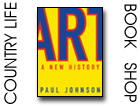Art: A New History
Art: A New History by Paul Johnson is an idiosyncratic and passionate history, perhaps old-fashioned to art historians but appealing to museum-goers, says Clive Aslet


Paul Johnson is a phenomenon. In the gaps between writing numerous newspaper columns on both sides of the Atlantic, he has, in the past, found time to produce several stonking histories, on epic themes. Now, in what for other men might have been a well-earned retirement, he has come out with a stupendous new history of art, whose length alone (more than 750 pages) demonstrates its scale.
Although the viewpoint is centred firmly in the Western tradition, Mr Johnson takes in anything of importance that he has encountered on his extensive travels, from the Taj Mahal to Tang horses.
This is not a book that could have been written by an art historian. Art history, as an industry, may have increased in line with the rising value of the art market over the past century, but this has encouraged specialisation rather than breadth. It is difficult to imagine that a 'professional' would jump into a big subject like this with both feet.
Mr Johnson has no such inhibition. He is passionate about art, and writes as someone who continues to wrestle with its challenges through his own watercolours. He is not afraid to praise beauty. He admires technique. He responds warmly to the delight which great paintings induce in the viewer. He does not flinch from sharing his personal hierarchy of achievement, which, as readers of his Spectator column will expect, is not always predictable. (The Sistine Chapel ceiling gets a low rating, the 17th-century Spanish realist Jusepe de Ribera a surprisingly high one.)
This will seem old-fashioned to art historians but appealing to museum-goers who go to art for enjoyment. Rembrandt never succeeded in painting a beautiful woman, says Mr Johnson. He has a point.
In other ways, the qualities that Mr Johnson brings to his task produce an original perspective. As a historian, he is able to relate the production of art to other events shaping the world. The decorative tendency in Spanish art is explained by the sheer volume that was required to fill the vast number of missions, churches and cathedrals in an expanding empire.
The Russian Ilya Repin's They Did Not Expect Him, 1884, sums up the brutality and inefficiency of the Tsarist regime. Similarly, Mr Johnson sees art in its context of use. Bernini completed St Peter's as 'the greatest processional route in the history of art', whose object was to stun princes coming to visit the Pope.
Exquisite houses, the beauty of Nature, and how to get the most from your life, straight to your inbox.
Being himself a man of the world, Mr Johnson is able to illuminate the motives that drove great artists to create incomparable works. Titian loved the money that he was good at gouging out of his patrons; Guido Reni ran a huge studio to support his gambling habit; Jan Steen liked to present himself as a drunkard.
Of all the figures in the book, the most complex and controversial is Picasso, responsible, in Mr Johnson's eyes for popularising an art based on ever-changing fashion rather than noble values. While struggling to be fair, he observes his degradation of women, willingness to oblige homosexuals and dodgy standing in wartime Paris - culminating in a conversion to Communism which was guaranteed to bring the French cultural establishment on side.
This is not a book that could have been written 25 years ago. Works such as the Chinese Emperor Quin's army of 7,000 pottery soldiers had not been discovered. Little was known of Russian art. Even now the 'history of American painting has yet to be written'. Many works of art, not all of which Mr Johnson likes, had not been created. That, for him, is a cause of hope. Mankind is in its infancy; art will go on evolving for as long as we have eyes, brains and hands.
OrderArt: A New Historytoday
Country Life is unlike any other magazine: the only glossy weekly on the newsstand and the only magazine that has been guest-edited by His Majesty The King not once, but twice. It is a celebration of modern rural life and all its diverse joys and pleasures — that was first published in Queen Victoria's Diamond Jubilee year. Our eclectic mixture of witty and informative content — from the most up-to-date property news and commentary and a coveted glimpse inside some of the UK's best houses and gardens, to gardening, the arts and interior design, written by experts in their field — still cannot be found in print or online, anywhere else.
